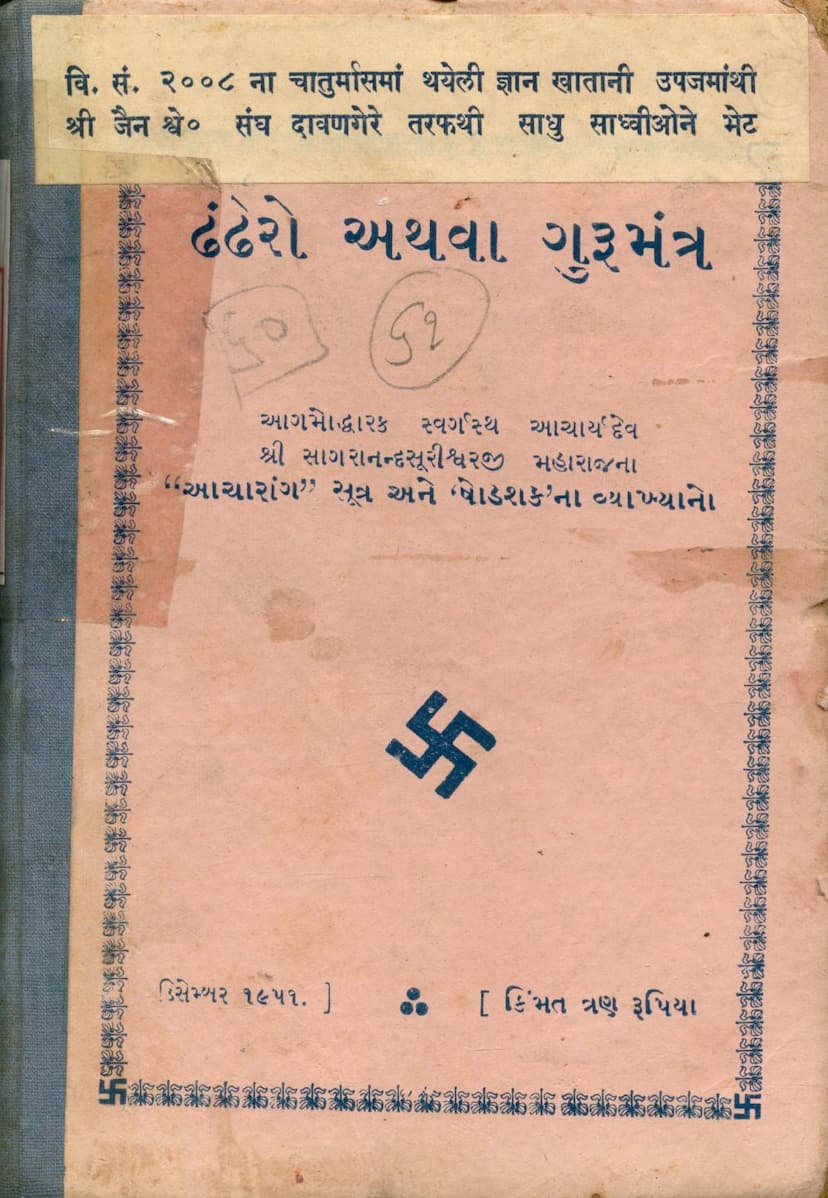Dhandhero Athva Gurumantra
Added to library: September 1, 2025

Summary
This Jain text, titled "Dhandhero Athva Gurumantra" (ઢંઢેરો અથવા ગુરૂ મંત્ર), is authored by Sagranandsuri and published by Ratanchand Shankarlal Shah. The book is a collection of discourses and explanations given by the late Acharya Dev Shri Sagranandsurishwarji Maharaj on the Acharanga Sutra and Shodashak (likely referring to a section or commentary on the Shodashak, possibly related to a philosophical or ethical treatise).
Here's a summary based on the provided pages, focusing on the key themes and content:
Core Theme: The "Dhandhero" or "Gurumantra" - The Proclamation/Great Teaching
The central idea of the book revolves around a "Dhandhero" (proclamation or declaration) or "Gurumantra" (great teaching) proclaimed by Lord Mahavir. This proclamation is presented as the essence of Jain philosophy and the path to spiritual liberation.
Key Concepts and Explanations:
-
The Essence of Jain Philosophy: The text emphasizes that the core of Jainism is the "Dhandhero," which is primarily about non-violence (Ahimsa). This teaching aims to bring peace and fearlessness to all souls, leading them to a state of bliss. The book's title itself signifies the importance of this core teaching.
-
The Significance of the Acharanga Sutra: The introduction highlights that while scholars mention eight virtues (like self-welfare, adhering to Dharma, Bhav Samvara, nascent Vivega, steadfastness in conduct, Tapasya, Karma Nirjara, and imparting teachings to others), not everyone can study the scriptures. Therefore, to benefit all beings, especially the young, the author (Sagranandsuri) presented teachings from the Agamas in a popular language, with this book being a part of that effort.
-
Structure of the Book: The preface outlines the structure of the first few chapters of the Acharanga Sutra as explained in the book:
- Chapter 1: The birth of a soul in the Six-Sensed bodies (Jivnikaya).
- Chapter 2: Victory over anger and other passions (Krodhadi).
- Chapter 3: Steadfastness in heat and cold, and the principle of non-attachment.
- Chapter 4 (starting here): "Samyaktva" (Right Faith), its various types, and the nature of knowledge and conduct.
-
Samyaktva (Right Faith): This is a major focus. The book delves into the various types of Samyaktva, the nature of knowledge and conduct (Jnana and Charitra). It also addresses incidental topics like:
- Why certain karmas are not "sukhavaraniya" (pleasure-giving).
- The reason for the main deity (Mulnayak) in temples.
- The concept of hell (Naraka) and who suffers most there.
- The principle that the Tirthankaras have no authority to harm any living being. This is presented as the central message of the "Dhandhero" and the heart of the entire Dwadashangi (the twelve Angas of Jain scripture).
-
Dhandhero (Proclamation) on Non-violence: The core of the Dhandhero is that no one has the right to harm another living being. Lord Mahavir declared this for the peace and fearlessness of the three worlds, showing the path to soul's happiness. This is the "Gurumantra" of Jainism.
-
The Nature of Violence and its Causes: The text discusses the nature of violence, the reasons for its intensity or mildness, and the elucidators of these concepts.
-
Key Jain Concepts Discussed: The book mentions and discusses various important Jain concepts, including:
- Sudeve: The correct definition of a true deity (Jineshwar).
- Mithyatva: False or wrong beliefs.
- Bhedniti: The policy of creating division (used by false beliefs to attract followers).
- Kshanikvad: The philosophy of impermanence.
- Niyativad: The philosophy of determinism.
- Navatattva: The nine realities.
- The Dwadashangi: The twelve limbs of Jain scripture, explaining their metaphorical representation as a "Pravachan Purush" (Discoursing Being).
- Anekantavada: The principle of manifold aspects.
- The importance of Acharanga: The first Anga, which describes the conduct of monks, as Achar precedes Vichar (conduct precedes thought).
-
The Author and Publisher: The book is attributed to Acharya Sagranandsurishwarji and published by Ratanchand Shankarlal Shah, with printing done at Anand Press, Bhavnagar. The preface is dated Kartik Vad 5, V.S. 2008 (December 1951). The price was three rupees.
-
Testimonials and Acknowledgements: The preface includes high praise for the author'a erudition and study from various Hindi and Gujarati periodicals and mentions a commendation from Pandit Sukhlalji Sanghavi. It also acknowledges the financial contribution from Seth Motaji Ragnathji Lakdewana for the publication.
-
Detailed Table of Contents: The included index (Anukramanika) is extensive, covering a wide range of topics discussed in the book, from the nature of Samyaktva, karma, the soul's journey, the essence of Jain beliefs, refutations of other philosophies, and detailed explanations of various Jain doctrines.
In essence, "Dhandhero Athva Gurumantra" is a profound exposition of fundamental Jain principles, with a particular emphasis on Samyaktva, Ahimsa, and the teachings of Lord Mahavir as the ultimate "Gurumantra" for spiritual upliftment, presented in a way that is accessible to the layperson. The discourses aim to clarify complex philosophical points and guide the reader towards right faith, knowledge, and conduct.